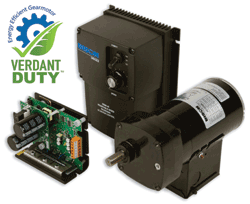The focus should be placed on improving and replacing more-ubiquitous fractional-horsepower devices
BY JOHN MOREHEAD
Bison Gear & Engineering
St. Charles, IL
http://www.bisongear.com
With the concerns over the growing energy crisis, the efficiency of electric motors has become an important, timely topic. The reason: electric motors consume from 63% to 70% of the electricity used in domestic manufacturing, and represent 23% of the total electricity consumption in the U.S.

However, most motor efficiency efforts to date have focused on only about 10% of the total electric motor population. A unique opportunity exists for OEM machinery designers to contribute to energy conservation efforts by carefully selecting and applying appropriate new electric motors, gearmotors, and drives.
Legislating efficiency
The 1992 Energy Policy Act (EPAct) and the Energy Independence and Security Act of 2007 (EISA) have done a lot to legislate new levels of increased motor efficiency. For good reason, these efforts have been primarily directed at integral (greater than one) horsepower electric motors.
Identifying the problem
An EPA study found that more than 80% of total electrical consumption for motors came from motors of 20 hp or greater. However, these larger motors represent less than 1% of all motors in use and it is estimated that motors in the 1 to 19-hp range represent an additional 9% of all motors in use.
The remaining 90% is made up of the billions of fractional horsepower (FHP) electric motors used literally everywhere: vent fans, ice dispensers, vacuums, furnace blowers, garage door operators, and thousands of other consumer applications. Millions more FHP motors and gearmotors are found in thousands of commercial and industrial applications involving pumping, dispensing, cooling, conveying, mixing, and every facet of automation.
To put fractional-horsepower motor efficiency into perspective, it helps to understand that, in general, the efficiency of electric motors increases with their size. Also, the gap between standard and premium efficiency motors decreases as motor horsepower ratings increase.
For example, a standard efficiency rating for a 1-hp motor might be 78%, while a premium efficiency for the same size would be 82.5%. However, for a 250-hp motor the standard efficiency increases to 94.1%, with a premium efficiency of 95.8%.
Boost FHP efficiency
In the FHP motor world, however, nominal efficiencies are much lower because their smaller physical size does not feasibly permit the inclusion of a greater percentage of copper or other efficiency improvement techniques employed in integral horsepower motors. Furthermore, the efficiency gap between a conventional FHP motor and an increased efficiency solution can be as much as 30% or more.
The potential energy cost savings can be significant, therefore, even with a small motor. For example, to operate a 50%-efficient 1/8-hp (93-W) gearmotor in California or Illinois, at a 10¢/kWh commercial rate, the annual cost will be $164.25. By comparison, the energy-efficient alternative at 80% efficiency, would only incur $102.20 in operating expense yielding annual savings of $62.05 to the user over the life of the machine.
PMDC vs. PSC
In some cases, it is possible to achieve significant efficiency increases by replacing a permanent split capacitor (PSC) ac motor with a permanent magnet dc (PMDC) motor. PSCs may have greater maximum efficiency, but their efficiency can be much lower at operating load point.
Three-phase trumps single-phase
Three-phase electric motors are typically more efficient than the single-phase alternative. For example, a single-phase 1/20-hp (37-W) gearmotor can have an efficiency of 53%, while the three-phase offers 64% efficiency.
In addition to greater efficiency, the three-phase motor is more reliable. A single-phase motor is not self-starting. Therefore, different starting mechanisms have been developed, which add to cost, component count, and are potential weak points in terms of maximized motor life.
So, if three-phase motors are so much better than single-phase, why aren’t they everywhere? For many commercial equipment installations, three-phase power is not readily available.
Enter the VFD
The logical solution is to power the three-phase motor from a frequency inverter that takes the single-phase 115- or 230-V input voltage and delivers 230-V three-phase output with adjustable frequency from typically 0 to 120 Hz. Thanks to the increasingly cost-effective electronics, variable-frequency drives (VFDs) have become more compact, offer more features, and provide exceptional value, even when compared to low-cost dc speed controls.
According to the ARC Advisory Group, the 2007 worldwide market for low-power VFDs was over $7 billion and is forecast to grow to almost $11 billion by 2012. Despite a softening economy, the demand for low-power ac drives will remain strong due to an overdue modernization of the industrial infrastructure that is currently underway.
The U.S. Department of Energy estimates that up to 18% of total electric motor energy consumption could be saved by controlling speed with VFDs. In fan, blower, and pump applications, VFDs can offer significant energy savings.
Rather than using a mechanical system to reduce flow, feeding a pressure sensor into a VFD can enable one to adjust flow more precisely and efficiently. Using a VFD to operate a fan, blower, or pump at 80% of rated speed can cut energy costs in half.
For FHPs, VFDs are somewhat more expensive than simple dc speed controls. But they offer many more features, such as soft starts to reduce shock to mechanical components and increase equipment life.
Don’t forget gearing efficiency
To maximize the overall efficiency of a gearmotor system, avoid negating motor efficiency gains with inefficient gearing. While a nice solution for tight spaces, right-angle worm-gear reducers can have efficiencies of 50% or lower, while spur and helical gears used in parallel-shaft reducers are more typically in the area of 98%. ■
Advertisement
Learn more about Bison Gear & Engineering





